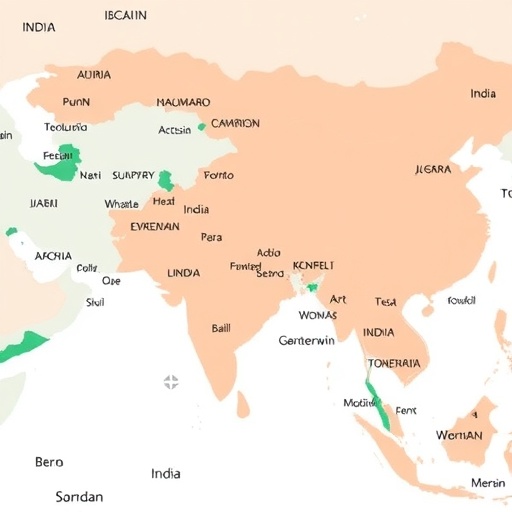In recent years, the interconnected nature of financial markets has captured the attention of economists and policymakers alike. In particular, the relationship between interest rates and inflation has emerged as a focal point of research, especially in developing regions like South Asia. This fascinating nexus compels a thorough examination, particularly considering the crucial role that risk premiums and economic growth play in shaping these dynamics. The latest research conducted by an esteemed team of scholars, including Rana, Ghosh, and Hasan, delves deep into this intricate web, bringing new insights to the forefront of economic discourse.
The foundation of this research lies in understanding how interest rates and inflation mutually influence each other. Interest rates, set by central banks, drastically impact the cost of borrowing and can direct capital flows within economies. Meanwhile, inflation—a persistent increase in price levels— often influences consumer behavior and economic sentiment. The study elucidates how these two variables are not merely independent mechanics but are intertwined in a complex relationship that influences economic growth.
Furthermore, the role of risk premiums cannot be underestimated in this calculus. Risk premiums, essentially the additional return that investors demand for taking on risk, have a significant impact on capital availability and economic activities. When risk premiums increase, capital becomes more expensive to obtain, thus influencing both inflation and interest rates. In contrast, lower risk premiums encourage spending and investment, stimulating economic growth, and potentially influencing inflation rates positively.
South Asia presents a unique landscape for this analysis. Comprising nations with diverse economic structures and growth trajectories, the region serves as a microcosm for understanding the broader implications of interest rates and inflation. The study highlights that while some countries experience hyperinflation—rendering their currencies unstable—others contend with stagnation that manifests through low growth and persistent unemployment. This dichotomy creates varied responses in terms of interest rates and inflation, further complicating the economic landscape.
A significant focus of the research is on the intricate balance that must be maintained by policymakers in South Asia. By carefully adjusting interest rates, central banks can influence inflation expectations and capital flows. However, the challenge lies in predicting economic behavior, particularly in times of uncertainty. The volatility of global markets and unexpected geopolitical events often-demand rapid adjustments to policy measures, which may not always lead to the desired outcomes.
One of the key findings of this study is the emergence of non-linear relationships between the studied variables. Contrary to the historical belief that higher interest rates always curtail inflation, the research indicates situations where the relationship may not hold. Instead, instances have been documented where rising interest rates have outpaced inflation, leading to adverse economic conditions, such as decreased consumer spending and investment stagnation.
The implications of these findings extend beyond theoretical economics. For investors, understanding the nuances of interest rate and inflation dynamics in South Asia is paramount for strategic planning. Investment portfolios may be sensitive to changes in interest rates, particularly in sectors heavily reliant on borrowing. The researchers emphasize the need for adaptive strategies that can respond to both long-term trends and short-term fluctuations in economic indicators.
Moreover, the research draws attention to the necessity of coordinated policy approaches within the region. Given the interdependencies among South Asian economies, decisions made by one nation can ripple across borders, influencing inflation and interest rates elsewhere. The scholars argue for a collective approach that recognizes the need for collaborative fiscal and monetary strategies to stabilize economies and ensure sustainable growth.
As the study unfolds, it introduces potential forecasting models that policymakers and economists can utilize to anticipate future trends. By understanding the complex interplay between interest rates, risk premiums, and inflation, better predictions can be made regarding economic performance. Empowering decision-makers with tools for predictive analytics could prevent future economic crises stemming from misunderstandings of these relationships.
In light of the findings, there’s a call to action for further interdisciplinary research, as economics intersects with sociology, environmental science, and political science. The dynamics of interest rates and inflation cannot be adequately understood without accounting for social factors and international relations—themes that warrant further exploration. This holistic approach to understanding economic phenomena could yield solutions that are both innovative and effective.
Particularly for the younger demographic in South Asia, the implications of these economic dynamics are profound. With rising student debt, economic uncertainty, and volatile employment markets, understanding the broader economic environment is essential for making informed financial decisions. The research serves as a beacon for educating the youth about fiscal responsibility and the consequences of accumulated debt in times of high-interest rates.
In summary, the groundbreaking research conducted by Rana, Ghosh, and Hasan sheds invaluable light on the nexus between interest rates and inflation in South Asia. With a focus on risk premiums and economic growth, their study heralds important findings that will enrich the discourse on economic policy in the region. By uncovering the subtle interactions and potential forecasting methodologies, they pave the way for a more stable and prosperous economic future.
The quest for understanding the intricate dynamics of interest rates and inflation is far from complete. Further exploration could reveal even deeper insights, ultimately leading to policy adjustments that promote sustainable economic growth across South Asia. As these scholarly contributions continue to unfold, it becomes increasingly clear that the quest for economic stability requires constant vigilance and a willingness to embrace complexity.
Subject of Research: The interplay between interest rates and inflation in South Asia, focusing on risk premiums and economic growth.
Article Title: The Nexus between interest rates and inflation in South Asia: the role of risk premiums and economic growth.
Article References:
Rana, M., Ghosh, S., Hasan, M.M. et al. The Nexus between interest rates and inflation in South Asia: the role of risk premiums and economic growth.
Discov glob soc 3, 105 (2025). https://doi.org/10.1007/s44282-025-00249-7
Image Credits: AI Generated
DOI: https://doi.org/10.1007/s44282-025-00249-7
Keywords: Interest Rates, Inflation, Economic Growth, Risk Premiums, South Asia, Economic Policy




